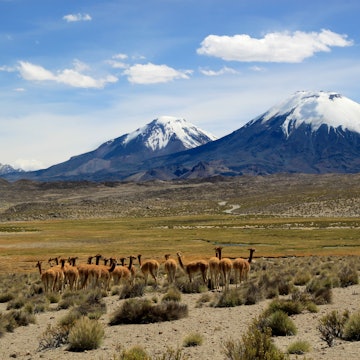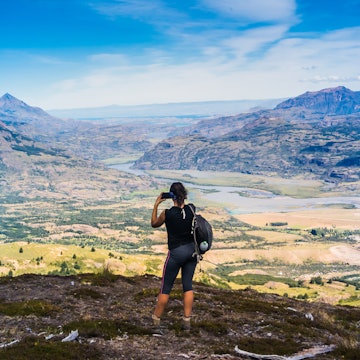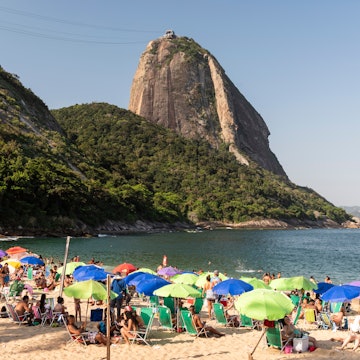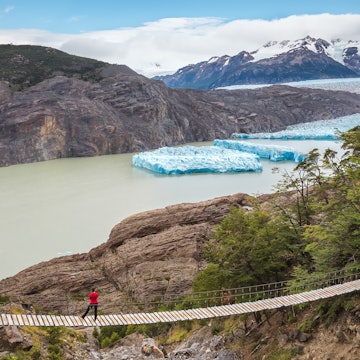
Sailing to Antarctica on the world's first hybrid cruise ship

Dec 18, 2019 • 6 min read

The MS Roald Amundsen is the world's first hybrid cruise ship © JOHAN ORDONEZ / Getty Images
“Good morning, ladies and gentlemen, welcome to Antarctica,” said Captain Kai Albrigtsen from the bridge of the world’s first hybrid cruise ship. After traversing the coast of Chile for eleven days, we had reached the Great White Continent, marking my 50th country and seventh continent. We were greeted by a giant floating iceberg topped with a rookery of penguins, and marveled at the vivid blue and white Antarctic landscape as our ship glided by.

The Hurtigruten line MS Roald Amundsen gives guests a unique experience not offered by any other cruise ship in the world – even in the already niche world of Arctic and Antarctic cruises. This 500-passenger ship operates much like a hybrid car, and balances using low-sulfur diesel with battery power.
I traveled on the ship’s 18-day maiden Antarctic voyage. To guests, the ship runs with much less noise than the average cruise ship with the majority of the ecofriendlier technology working quietly behind the scenes. Heading south from colorful Valparaiso, we spent several days at sea, hitting some rough waters. But the ship’s innovative, narrow hull eased the seasickness, and cut through the waves instead of hitting them straight on.
You might also like: Antarctica: your guide to adventure

A few days later, we docked on the 60-inhabitant island of Puerto Edén. Walking around the seaside town’s winding wooden paths and stairs, we saw plenty of photogenic cats and dogs. After our shore excursion the local kids were invited back onto the Roald Amundsen to drink hot chocolate, visit the state-of-the-art Rolls Royce–designed bridge, and learn about the new hybrid ship.
After the kids disembarked and the locals waved us goodbye, we sailed off to Puerto Natales, the gateway to Torres Del Paine National Park. A bucket-list excursion to the park involved a day full of jagged mountain peaks, glaciers, waterfalls, and lots of wind. The following day we wandered around the backpacker town of Puerto Natales, where the streets are lined with colorful houses, shops piled with wool, and cafes selling dulce de leche cakes.

The next three days were spent at sea. On-board entertainment included hourly lectures in the ship’s Science Center, drinking milkshakes at Fredheim – the ship’s trendy eatery – and crossing the infamous Drake Passage, the most treacherous body of water in the world.
Karin Strand, the renowned Arctic explorer, Hurtigruten expedition leader, and godmother to the MS Roald Amundsen, has crossed the Drake Passage nearly 300 times. According to Strand, you’ll get the 'Drake Shake' (rough seas) 30 percent of the time and the 'Drake Lake' (calm waters) 70 percent. On our day-and-a-half journey south, we got a bit of both, with the biggest swell being nearly 30ft high.

On day 12 of the voyage, we awoke to Captain Kai Albrigtsen welcoming us to Yankee Harbour in the South Shetland Islands. The ship’s passengers were brimming with excitement, and I wasn’t the only one who was ready to disembark and see some penguins. The Hurtigruten team briefed us on how to interact with wildlife and what to do to minimize our impact on the pristine environment.
Once on land, we followed a trail of red flags marking the path, and I was immediately faced with the biggest creature I’d ever seen – a 4000lb elephant seal plopped right there on the ice. On the other side of the path was a curious Weddell seal, lifting its head up as if posing for pictures.

We continued on the trail, which led to a giant penguin rookery with thousands of gentoo penguins setting up their nests for the season. We watched them waddle back and forth, glide on their stomachs and lift rocks with their beaks. For me, that was it – my hopes for Antarctica had already been exceeded. I’d seen everything I wanted to see, and it was only the first day on Antarctica proper.
On our second day, we woke up to blue skies and barely any wind in Chiriguano Bay. It was ideal weather for a historic day, both for Hurtigruten's MS Roald Amundsen and for its passengers: the first ever ship-naming ceremony in Antarctica.
Try this: How to pack for a trip to Antarctica
In the morning, we gathered with crew and passengers from another of Hurtigruten's ships, the MS Midnatsol, as Karin Strand broke a chunk of ice on the Amundsen. In doing so, she christened the world’s first hybrid cruise ship in honor of the first South Pole explorer Roald Amundsen, who also skipped the traditional bottle of champagne in favor of ice when he named his famed expedition ship, Maud, in 1917.

Later that day we docked in Wilhelmina Bay on the Antarctic peninsula and boarded the Hurtigruten’s small boats for some ice cruising. Once on the water, the engine was cut, and we floated in complete silence, enjoying the peace and the beauty of Antarctica as gigantic icebergs and a few leopard seals moved all around us.
The weather rewarded us that evening with an enchanting sunset unlike any I’d seen before. On the Antarctic peninsula, dusk fades into sunset over the course of hours, slowly changing the sky and glaciers from bright blue to an otherworldly pink. We stayed cozy in the ship’s hot tub – which recycles water warmed by the engine cooling system – watching the alpenglow with cocktails in hand.
On our third day, we landed on Orne Harbour on the actual Antarctic continent. We hiked to the top of a peak which overlooked the surrounding mountain ranges, their crests capped with cascades of wispy clouds. Even more engaging was the chance to visit another penguin rookery, where we watched the chinstrap penguins scurry back and forth along the ice. Later that day, we paddled kayaks alongside them as they swam in the shadows of massive glaciers.

During our final landing in Antarctica, we caught a glimpse of the Argentinian research center on Half Moon Island. The first half of our visit was spent observing the chinstrap penguins once more as they traveled from their rookery on the top of the hill down to the rocky beach. Then we got a chance to join them for a swim during my first-ever polar plunge.
I stripped down to my bathing suit and walked as quickly as I could into the 36°F (2°C) water. The swim only lasted about ten seconds as my body was shocked numb but I earned a certificate from Hurtigruten to prove I did it.
After warming back up with a mug or two of hot chocolate, we lucked into humpback whale sightings. Soon it was time to return to shore for snowshoeing to the top of a lookout for our last magical views of of the Great White Continent.
We glided out of the bay and through what was, fortunately, a Drake Lake crossing to Punta Arenas, also known as the End of the Earth. There, a charter flight was waiting to take us back to Santiago, Chile. Taking souvenirs from Antarctica itself is forbidden, but I made sure I picked up a penguin made of wool at the airport as my keepsake for the trip of a lifetime.













